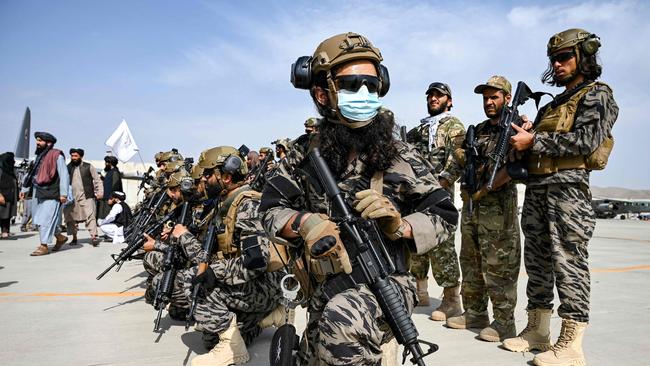Afghanistan is liberated, but all they have left us is ruins, says Taliban
The abandoned war machines of a defeated superpower were fit only for the scrap heap as the Taliban swarmed in.

The abandoned war machines of a defeated superpower were fit only for the scrap heap as the Taliban swarmed into Hamid Karzai International Airport.
They littered the hangars around the runway, smashed and inoperable, after the last US plane had lifted off, the fading sound of its engine and the chatter of Taliban celebratory fire bringing to an end America’s 20-year war in Afghanistan.
Walking through the wreckage of perforated metal, cut wiring and shattered control panels, among the clothes and uniforms left by evacuated civilians and fleeing Afghan soldiers, the Taliban celebrated the immensity of their victory with delight – as well as the peculiar sense of anticlimax that so often snaps at the heels of an enemy’s defeat.
“Not a single foreign soldier left in Afghanistan – the victory of our jihad could never be sweeter!” said Mohsen, a 23-year-old soldier from the Taliban’s elite Fateh unit, as he stared across a hangar floor covered with the helmets, body armour and hand grenades left by his Afghan special forces adversaries. “But the infidels destroyed everything.
“There is little left for us to capture here. Our country is liberated but the Americans have left us with junk.”
Twenty-four hours before their August 31 deadline, the Americans on board that last C-17 aircraft, call sign Moose 85, left a minute before midnight, local time on Monday.
The last US soldier out of Afghanistan, Major General Chris Donahue, commander of the 82nd Airborne Division, was photographed by a night vision camera walking up the ramp of the plane.
It was the last act of an occupation that cost more than 170,000 lives, including those of more than 2400 American troops, 454 British personnel and 43 Australians, cost trillions of dollars, and ended in the complete victory and takeover of Afghanistan by the insurgent force that the US-led coalition had spent two decades trying to defeat.
In the preceding hours the US troops and their Afghan allies had withdrawn behind a final cordon lined with upturned vehicles and coils of razor wire, after handing the perimeter over to the Taliban: a last defensive position described as being “like the Alamo” by one US official.
They ensured that not a single helicopter or plane among the fleet of 73 being left behind could serve the Taliban, scrupulously destroying all their engines and control systems.
Most of the coalition’s abandoned trucks and personnel carriers were similarly disabled, although the Taliban managed to find several working armoured vehicles and a special forces dune buggy, which they raced around the empty runways in victory laps.
As storm clouds darkened the morning sky, the aftermath of withdrawal looked sombre: a mechanical graveyard of drooping rotors, tilted wings, holed fuselages and pools of hydraulic fluid.
So complete was the destruction – some by US forces but also by looters who breached the perimeter fence before it could be secured on August 15 – that neither the smallest room nor the biggest hangar appeared unmarked. Computers and screens had been smashed along with aircraft and Humvee engines; even the plates in the departure lounge kitchen had been broken one by one.
Awnings above the terminal buildings showing the faces of the ousted president Ashraf Ghani and the famed dead Mujaheddin leader Ahmad Shah Massoud had been ripped or torn down. At the departure gates were a jumble of razor wire, bullet casings, glass, water bottles and human excrement.
A combination of absent airport staff, including senior officials who fled the country, and the destruction in the last days of the evacuation has left Kabul airport without air traffic control. US civil aircraft are now banned from operating over Afghanistan unless given authorisation, the US Federal Aviation Administration confirmed on Monday.
On Sunday the US, Britain and 96 other countries said that they would continue to take in people fleeing Afghanistan and had secured an agreement with the Taliban to allow safe passage. A day later the UN Security Council adopted a resolution requiring the Taliban to honour the agreement to let people freely leave Afghanistan. However, it stopped short of agreeing to a call by French President Emmanuel Macron to create a “safe zone” in Kabul, which means that the mechanism to allow vulnerable Afghans to leave will depend on the Taliban.
Outside the Kabul airport perimeter on Tuesday, now cleared by the Taliban of the thousands of civilians who had crowded there over the past fortnight in scenes often characterised by violence, fear and humiliation, a handful of those seeking to leave had returned – despite the absence of any further flights.
“For those of us left behind, today is not a day of victory but one of fear,” said an Afghan who had worked with the coalition but who had not been able to get on an evacuation flight. “The only certainty we have is that our tomorrow will be a day of even greater fear.”
The Times



To join the conversation, please log in. Don't have an account? Register
Join the conversation, you are commenting as Logout